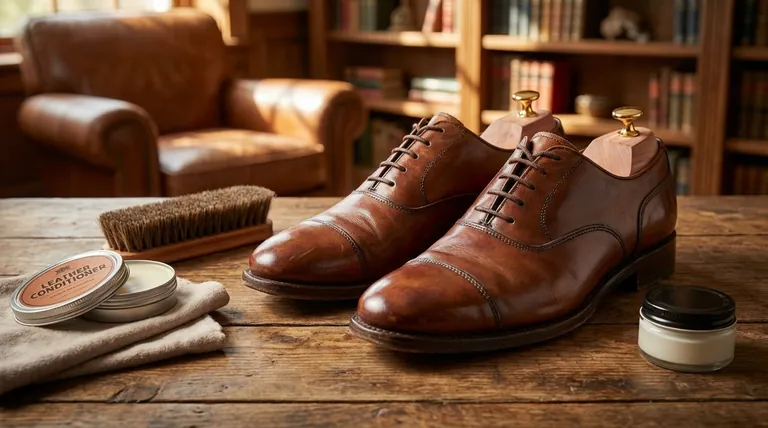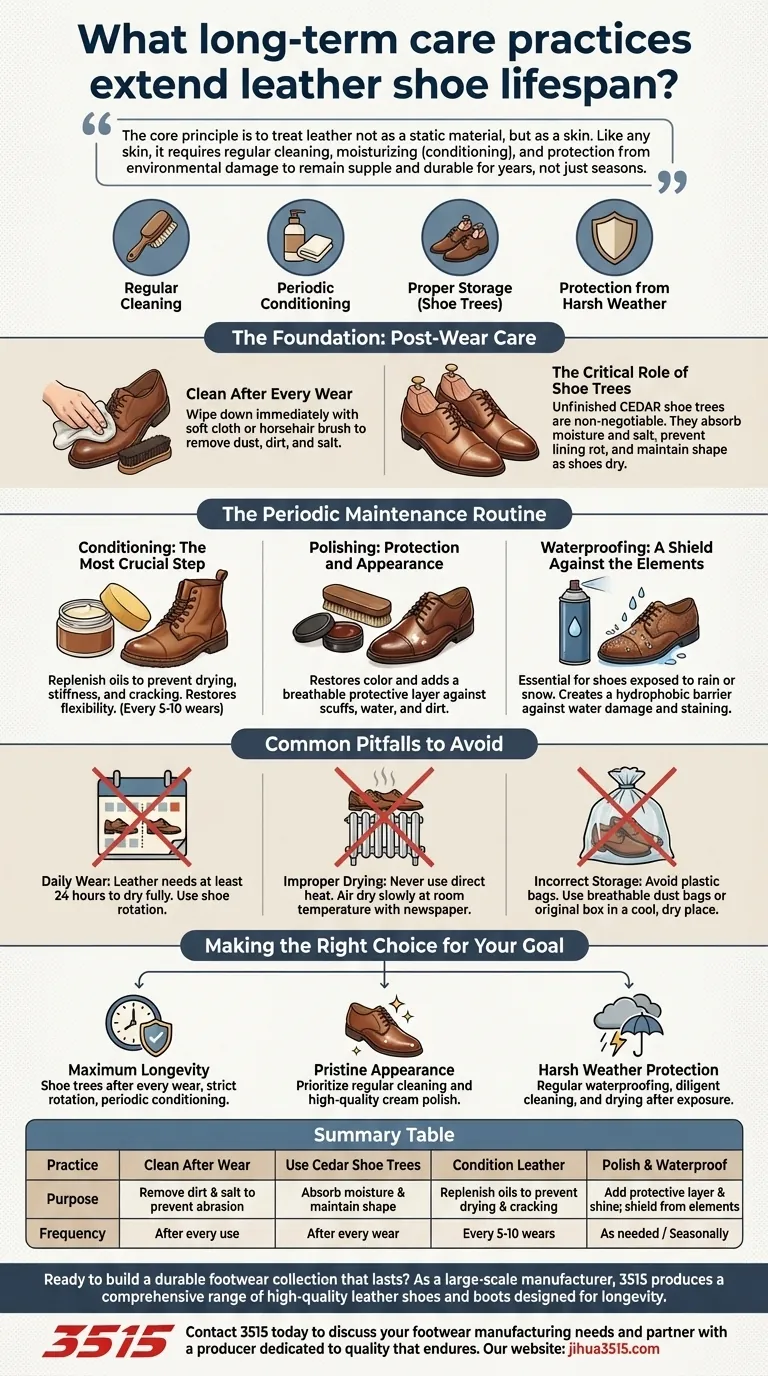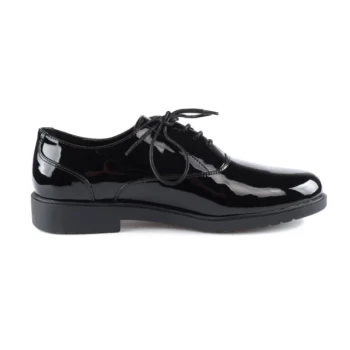To extend the lifespan of your leather shoes, you must adopt a consistent routine of care focused on four key areas: regular cleaning, periodic conditioning, proper storage using shoe trees, and protection from harsh weather. These practices work together to preserve the leather's natural structure, preventing it from drying, cracking, and losing its shape over time.
The core principle is to treat leather not as a static material, but as a skin. Like any skin, it requires regular cleaning, moisturizing (conditioning), and protection from environmental damage to remain supple and durable for years, not just seasons.

The Foundation: Post-Wear Care
The most significant damage to leather shoes occurs in the hours after you take them off. Establishing a simple but consistent post-wear routine is the single most effective way to ensure their longevity.
Clean After Every Wear
Immediately after wearing, wipe your shoes down with a soft cloth or horsehair brush. This removes surface-level dust, dirt, and salt, which can abrade the leather's finish and draw out essential moisture if left to sit.
The Critical Role of Shoe Trees
A pair of unfinished cedar shoe trees is a non-negotiable investment. They perform two critical functions that dramatically extend a shoe's life.
First, they absorb the moisture and salt from perspiration that accumulates inside the shoe, preventing the lining from rotting and the leather from deteriorating. Second, they help the shoe maintain its original shape as it dries, smoothing out creases in the vamp that can eventually turn into deep cracks.
The Periodic Maintenance Routine
While daily care is foundational, a more thorough maintenance routine performed periodically will restore and protect your shoes for the long term. The frequency depends on how often you wear them, but a good baseline is every 5-10 wears.
Conditioning: The Most Crucial Step
Leather is a porous, natural material that loses its oils over time, causing it to become dry, stiff, and brittle. Conditioning is the process of replenishing these oils.
Using a quality leather conditioner restores the material's flexibility and prevents the formation of cracks. This is the single most important step for preserving the structural integrity of the shoe.
Polishing: Protection and Appearance
Polishing does more than just create shine. A quality cream or wax polish restores color and adds a thin, breathable protective layer to the leather's surface. This layer acts as a barrier against minor scuffs, water, and dirt.
Waterproofing: A Shield Against the Elements
For shoes regularly exposed to rain or snow, applying a waterproofing treatment is essential. These products, often wax-based or sprays, create a hydrophobic barrier that prevents water from soaking into the leather and causing permanent damage or staining.
Common Pitfalls to Avoid
Correct practices are important, but avoiding common mistakes is just as critical. Many well-intentioned owners inadvertently shorten their shoe's lifespan.
The Mistake of Daily Wear
Leather needs time to dry fully between wears, a process that can take at least 24 hours. Wearing the same pair of leather shoes two days in a row traps moisture, accelerates the breakdown of the material, and prevents the shoe from recovering its shape. Shoe rotation is essential.
Improper Drying Techniques
If your shoes get soaked, never place them near a direct heat source like a radiator or vent. This will "cook" the leather, causing it to dry out too quickly, become brittle, and crack. Instead, stuff them with newspaper and let them air dry slowly at room temperature, preferably with shoe trees inserted after a few hours.
Incorrect Storage
Long-term storage requires protection. Storing shoes in a plastic bag or container can trap moisture and promote mold growth. Instead, place them in breathable dust bags or their original box in a cool, dry place away from direct sunlight.
Making the Right Choice for Your Goal
Your specific maintenance routine should align with how you use your shoes and what you want to achieve.
- If your primary focus is maximum longevity: The non-negotiables are shoe trees after every wear, a strict rotation schedule, and periodic conditioning.
- If your primary focus is maintaining a pristine appearance: Prioritize regular cleaning and polishing with a high-quality cream polish to keep the leather nourished and scuff-free.
- If your primary focus is protection in harsh weather: Make waterproofing a regular part of your routine and be diligent about cleaning and drying your shoes immediately after exposure to rain or snow.
By implementing these practices, you transform shoe care from a chore into a rewarding ritual that protects your investment for years to come.
Summary Table:
| Practice | Purpose | Frequency |
|---|---|---|
| Clean After Wear | Remove dirt & salt to prevent abrasion | After every use |
| Use Cedar Shoe Trees | Absorb moisture & maintain shape | After every wear |
| Condition Leather | Replenish oils to prevent drying & cracking | Every 5-10 wears |
| Polish & Waterproof | Add protective layer & shine; shield from elements | As needed / Seasonally |
Ready to build a durable footwear collection that lasts? As a large-scale manufacturer, 3515 produces a comprehensive range of high-quality leather shoes and boots designed for longevity. Whether you are a distributor, brand owner, or bulk client, our expertise ensures your products are built to meet the highest standards of durability and care.
Contact 3515 today to discuss your footwear manufacturing needs and partner with a producer dedicated to quality that endures.
Visual Guide

Related Products
- Custom OEM Training Shoes Wholesale Manufacturer Durable & Breathable
- Durable Leather Safety Boots for Wholesale & Custom OEM Manufacturing
- Safety Footwear Wholesale Manufacturer for Custom OEM/ODM Production
- Wholesale Comfortable Business Casual Shoes Custom Manufacturing
- Advanced KPU Athletic Safety Shoe with Steel Toe Cap Anti-Slip Rotary Lacing System
People Also Ask
- What improvement in 2-mile run time could be expected with a 10% improvement in running economy from super boots? Achieve a 7.9% to 15.1% Time Improvement
- What industries benefit from safety trainers? Lightweight Protection for Modern Workplaces
- What are the main types of reinforced toe protection for tactical boots? Choose the Right Toe for Your Mission
- What are the features of non-slip athletic sneakers? The Ultimate Guide to Traction & Performance
- What are some pros mentioned for women's non-slip shoes? Boost Safety, Comfort & Style



















